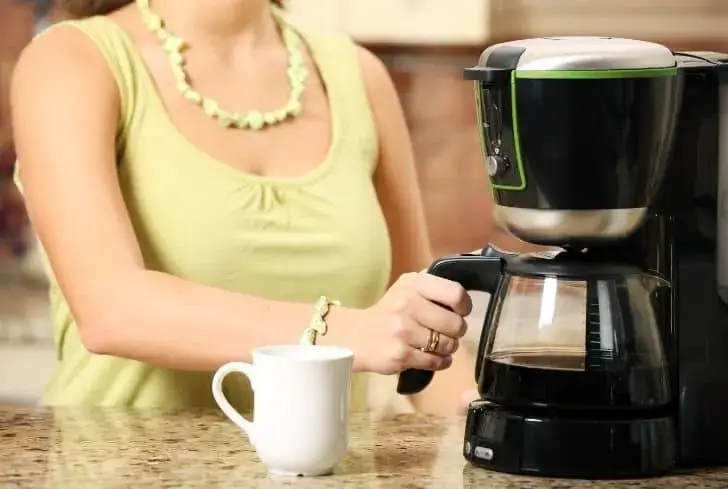Last Updated on August 9, 2023 By Emma W. Thomas
Cleaning a coffee maker with bleach is not recommended due to health risks. Bleach can leave harmful residues and potentially alter the taste of coffee. Use vinegar or specialized coffee machine cleaners for safe and effective cleaning.
Why Is Cleaning Your Coffee Maker With Bleach So Unsafe?

Everyone knows that bleach is not a harsh chemical substance that consists of several toxic chemical components. Once you use bleach to clean the inner portion of the coffee maker, you can’t brew out the bleach entirely. A small amount of beach remains inside the coffee maker. The small amount of bleach gets mixed with coffee eventually, and you consume that. Consuming bleach particles can cause mild to a severe lung infection that takes a long time to be cured.
Apart from that, the bleach particles can damage the brewing mechanism of your machine. If that happens, you won’t be able to prepare coffee with that machine in the same way you used to do previously. The device won’t function properly if the brewing mechanism gets blocked with the residual amount of bleach.
That’s why it’s highly advisable not to use bleach while cleaning the inner portion of the machine. Besides causing health hazards, that kind of activity can damage your machine as well. Coffee maker devices are usually expensive, and you definitely don’t want to damage your machine anyway.
Which Alternative Ways Are The Best In Terms Of Cleaning Your Coffee Maker?
There are several cleaning options that you can avail to clean your coffee maker. Here we are suggesting the best ways that you can follow while cleaning your coffee maker.
Vinegar Is A Great Option
Vinegar is a cheap option that you can apply inside the coffee pot to clean that. You will get vinegar in the local grocery stores at affordable prices. Here’s how you can use vinegar to clean your coffee maker-
- First of all, you must create a mixture of water and vinegar. In that mixture, water and vinegar should be in 1:1 proportion. Once the mixture is ready, pour that inside the reservoir of the coffee maker.
- Then you should run the coffee maker for a few moments. After a few seconds, you will notice that the machine is brewing out the solution. Wait until the machine brews out the solution completely.
- After that, you have to fill the reservoir with normal water and again run the machine. This time the coffee maker will brew out every single particle that was inside the pot along with water.
- You should keep repeating the cycle until you find that the pot is completely clean.
Using Baking Soda Can Also Help
Almost everyone has baking soda in the kitchen. So, you won’t have an issue while getting baking soda. Let’s jump to the procedure of how you can clean the coffee maker with baking soda.
- Firstly, you have to prepare a solution of baking soda and water in this case as well. The quantity of baking soda is an essential factor here. One-quarter cup of baking soda is suitable for cleaning a medium coffee maker. You have to add one-quarter cup of baking soda to a glass of water and mix the solution properly. After that, you should fill the reservoir with a solution of water and baking soda.
- Alike in the previous method, you have to run the coffee maker, and it will brew out the solution.
- After the coffee maker brews out the solution correctly, fill the reservoir again with water. Then turn on the coffee maker and let it brew out everything inside along with the water.
Apart from these two ways, coffee maker cleaners are also available in the market. Anyway, baking soda is comparatively less effective than the other options when it comes to cleaning coffee makers.
The Following Table Will Help You To Understand Whether Vinegar Or Coffee Maker Cleaner Is More Effective.
| Coffee Maker Cleaner | Vinegar |
| A coffee maker is more efficient in cleaning the reservoir of the coffee maker due to the presence of cleaning components. | Vinegar is less efficient than a coffee maker cleaner due to the absence of chemical cleaning components. |
| Coffee maker cleaners are more expensive than vinegar and not available in the market always. | Vinegar is a regular kitchen component. Moreover, vinegar is less expensive than a coffee maker cleaner. |
| A coffee maker cleaner doesn’t leave sediments inside the reservoir. | While cleaning with vinegar, a small amount of vinegar can remain inside the reservoir. |
This table clearly states that a coffee maker cleaner is a safer and better option while cleaning the coffee maker. If the price factor is bothering you, you can use vinegar for cleaning the coffee maker. Otherwise, we suggest you go for coffee maker cleaners.
How To Clean Your Coffee Maker Safely Using Bleach?
Whatever you clean with bleach, you have to leave that in the open air after rinsing. Without air drying, small particles of bleach don’t go away completely. Air drying isn’t possible when you apply bleach for cleaning the inner portion of the coffee maker. That’s not an open surface, and the residual amount of bleach remains there, after cleaning for that reason.
Anyway, cleaner the outer surface of the coffee maker is safer to clean with bleach. You can use bleach for cleaning the outside area of the coffee maker. However, rinsing and air drying the surface properly is mandatory. You must take the required precautions to get rid of the caustic nature of bleach.
Let’s check out how to clean the outer portion of your coffee maker using bleach.
- Apply bleach all over the outer surface of the coffee maker and scrub the surface properly.
- After that, rinse off the surface gently with normal water.
- Use a piece of fresh cloth or sponge to wipe the water from the surface.
- Let that surface dry for 1-2 hours in the open air before you use the device again.
Following these steps will help you to clean the outer portion of your coffee maker with bleach.
What If You Have Already Used Bleach For Cleaning The Inner Portion Of Your Coffee Maker?

If you have already applied bleach for cleaning the inner pot of the coffee maker, you have to try to flush out the bleach. As mentioned before, a small portion of bleach remains inside after cleaning the inner pot of the coffee maker. Many people think that applying vinegar in such a situation will be helpful to flush out the residual bleach. That’s not true anyway, and the result of such an activity can be dangerous. If you pour vinegar inside the coffee pot in such a situation, the reaction between vinegar and bleach produces a toxic gas. Therefore, refrain from using vinegar in such a condition.
Instead, fill the coffee pot with normal water and turn on the coffee maker. The coffee maker will brew out the mixture of water and the residual amount of bleach. Repeat this process until the coffee pot is completely clean. After that, let the pot open for some time to get dry, and the bleach particles will eventually go away.
This is the simplest process to clean your coffee maker if you have applied bleach inside it.
Bottom Line
Taking the risk of cleaning your coffee maker with bleach won’t be a wise choice for you. Instead, you can choose any of the cleaning techniques that are mentioned above. Never put yourself or your family members at risk by cleaning your coffee maker with bleach. That might lead you and your family member toward health hazards.
References:
https://coffeeaffection.com/how-to-clean-a-coffee-maker-with-bleach/
https://baristahq.com/how-to-clean-a-coffee-maker-with-bleach/
Emma is a graduate of Domestic Science or Family and Consumer Sciences (Home Economics) from the University of Wisconsin. She has 7 years of experience Working with the strategic section of BestBuy and now writing full-time for Homeeon.
From Managing the Home, Interiors, Cleaning, and Exteriors to Gardening and everything about Making A Home Liveable – is her passion and this Homeeon is the result of this.
Emma loves decorating her home with the best stuff found online. She cares about quality over anything and writes reviews about them here in Homeeon. Get in touch with her over Pinterest.
Keep reading her blogs.

